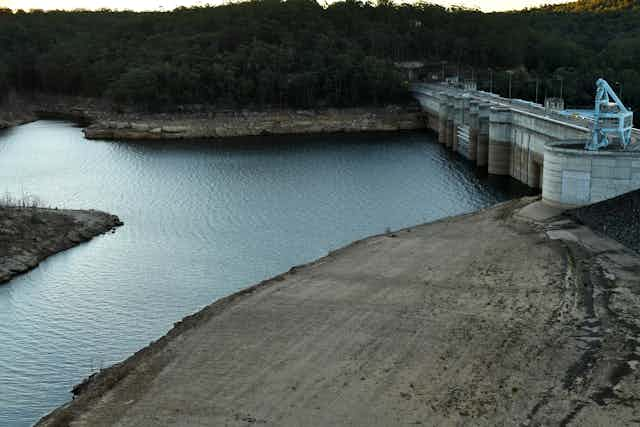The level of water stored by Australia’s capital cities has steadily fallen over the last six years. They are now collectively at 54.6% of capacity – a decline of 30% from 2013.
We’re going into a hot summer and Sydney has just announced level 2 restrictions, the toughest for any capital. Data from the Bureau of Meteorology shows other capital cities facing mixed results.
The results show that Darwin’s water supply has lost about 25% over the last year. On the plus side, Melbourne’s supply actually increased over 2019, having fallen below 50% earlier this year, and now sits on 63.9%.
While the national average is trending downwards, the patterns for each city are very different. Sydney and Perth water supplies have had contrasting journeys over the last six years. In October 2013 Perth’s supply was a very low 33.8% and Sydney was a comfortable 91%.
Now, for the first time in many years Perth does not have Australia’s lowest level of all capital city water storages. As of last week, Sydney has taken this unwanted distinction from Perth.
For Perth residents, the news is good as their surface water storages are at a six-year high of 46.4%. In Sydney they are worried, as they have a six-year low of 46.2%.
Sydney has experienced a steep decline over the last 30 months, from nearly full storages (96%) in April 2017. The speed and severity of the Sydney drought is starting to resemble previous dry spells. One was in the 1940s and the other was the Millennium drought.
Perth has lived with the most water stress of any capital city. They have had to contend with a steady 45-year decline in rain. The inflow of water into Perth’s dams has also fallen dramatically.
Perth has adapted to its drying climate by sourcing water from many different supplies. It now uses its surface water storages for about 10% of its water supply. Much larger proportions of Perth’s supply comes from its two desalination plants, which unlike the other capitals are constantly in operation. It makes greater use of groundwater and highly treated recycled water. Perth also has permanent water restrictions.
Sydney’s desalination plant, after hibernating for 7 years, is now supplying water. It was switched on in late January 2019 when Sydney supply hit 60%, and can supply 15% of water demand. Unusually perhaps, the desalinated water does not reach all parts of Sydney.
Sydney Water has announced plans to double the capacity of the desalination plant. Construction is expected to begin soon.
Melbourne and Brisbane water supplies are currently at similar levels. However, since 2013 Melbourne’s storages have generally been lower than Brisbane’s. Melbourne’s supply has risen in 2019 after good winter rainfall in its catchments. The storages have increased from under 50% (49.6%) in late May 2019. Today, Brisbane storage levels are now at 59.2%.
Melbourne residents use less water than the other capital cities. In 2018 the average Melbourne resident used 161 litres per day, approximately 30% less than Sydney residents.
Melbourne’s supplies have also been supplemented with the reactivation of its Wonthaggi desalination plant in 2019. It is Australia’s largest desalination plant, capable of producing 410 million litres a day.
Read more: Why Sydney residents use 30% more water per day than Melburnians
Brisbane also built a desalination plant after the Millennium Drought. In addition, they also made very large investments in Australia’s largest waste water recycling scheme. The Western Corridor recycled water scheme opened in 2008, cost $2.5 billion and features three advanced waste water treatment plants, with more than 200 km of pipelines and three advanced waste water treatment plants.
Hobart, Darwin and Canberra are the three Australian capital cities without desalination plants. Canberra has had a steady decline in its supply over three years. It was full in October 2016, gradually dropping to 51.6% in November 2019. Hobart’s storages were above 80% for most of the last six years. They were just above 90% 12 months ago and have since fallen to their current level of 72%.
Read more: Fish kills and undrinkable water: here's what to expect for the Murray Darling this summer
Darwin’s water supply was full as recently as April 2018. Now, 18 months later, it is just touching 54%. This is its lowest level in six years. Darwin, our tropical capital, has the most seasonal rainfall of Australia’s capitals. Typically, they have almost no rain June to September during their dry season, and a wet season of heavy rains from October to April. However, the last wet season was one of the driest on record.
Adelaide’s water storage has fluctuated over the last 6 years. Adelaide gets more rain in winter and has dry summers, an opposite pattern to that of Darwin. Over the last 3 years the level has dropped from over 97% in October 2017 to just below 58%.
Read more: Up the creek: the $85 million plan to desalinate water for drought relief
The desalination plant in Adelaide can supply up to 50% of its water supply. It has been operating in 2019, although not in the wetter months of July and August. The Murray also continues to supply a large proportion of Adelaide’s water supply. The Commonwealth has agreed to use drought funding for the Adelaide desalination plant, so more river water can be used by farmers upstream to grow fodder for livestock.
Australia is set for a dryer and hotter summer than average, particularly in the east. Coupled with continued high levels of household demand, we can expect further declines in water storage levels through the first half of 2020.

